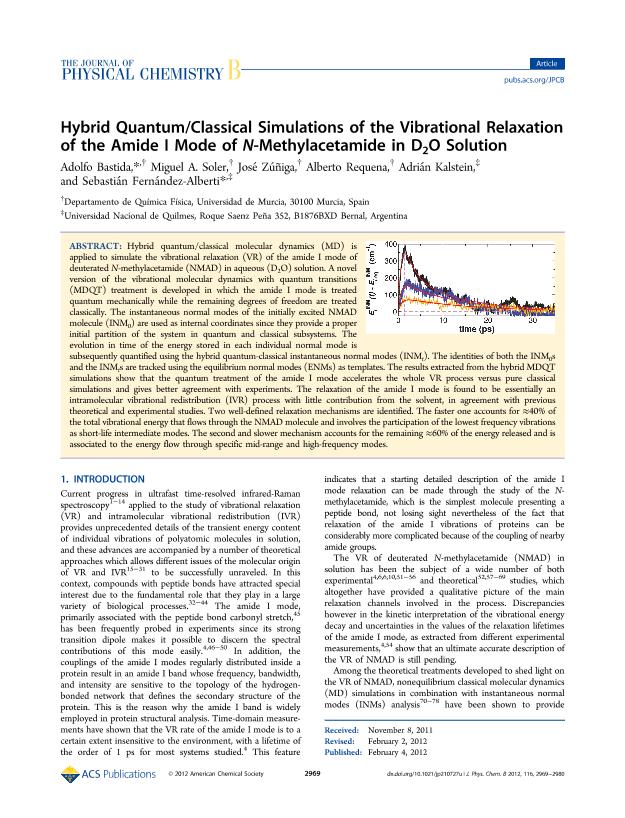Artículo
Hybrid Quantum/Classical simulations of the vibrational relaxation of the Amide I mode of N-methylacetamide in D2O solution
Bastida, Adolfo; Soler, Miguel A.; Zúñiga, José; Requena, Alberto; Kalstein, Adrian ; Fernández Alberti, Sebastián
; Fernández Alberti, Sebastián
 ; Fernández Alberti, Sebastián
; Fernández Alberti, Sebastián
Fecha de publicación:
02/2012
Editorial:
American Chemical Society
Revista:
Journal of Physical Chemistry B
ISSN:
1520-6106
Idioma:
Inglés
Tipo de recurso:
Artículo publicado
Clasificación temática:
Resumen
Hybrid quantum/classical molecular dynamics (MD) is applied to simulate the vibrational relaxation (VR) of the amide I mode of deuterated N-methylacetamide (NMAD) in aqueous (D2O) solution. A novel version of the vibrational molecular dynamics with quantum transitions (MDQT) treatment is developed in which the amide I mode is treated quantum mechanically while the remaining degrees of freedom are treated classically. The instantaneous normal modes of the initially excited NMAD molecule (INM0) are used as internal coordinates since they provide a proper initial partition of the system in quantum and classical subsystems. The evolution in time of the energy stored in each individual normal mode is subsequently quantified using the hybrid quantum-classical instantaneous normal modes (INMt). The identities of both the INM0s and the INMts are tracked using the equilibrium normal modes (ENMs) as templates. The results extracted from the hybrid MDQT simulations show that the quantum treatment of the amide I mode accelerates the whole VR process versus pure classical simulations and gives better agreement with experiments. The relaxation of the amide I mode is found to be essentially an intramolecular vibrational redistribution (IVR) process with little contribution from the solvent, in agreement with previous theoretical and experimental studies. Two well-defined relaxation mechanisms are identified. The faster one accounts for ≈40% of the total vibrational energy that flows through the NMAD molecule and involves the participation of the lowest frequency vibrations as short-life intermediate modes. The second and slower mechanism accounts for the remaining ≈60% of the energy released and is associated to the energy flow through specific mid-range and high-frequency modes.
Archivos asociados
Licencia
Identificadores
Colecciones
Articulos(SEDE CENTRAL)
Articulos de SEDE CENTRAL
Articulos de SEDE CENTRAL
Citación
Bastida, Adolfo; Soler, Miguel A.; Zúñiga, José; Requena, Alberto; Kalstein, Adrian; et al.; Hybrid Quantum/Classical simulations of the vibrational relaxation of the Amide I mode of N-methylacetamide in D2O solution; American Chemical Society; Journal of Physical Chemistry B; 116; 9; 2-2012; 2969-2980
Compartir
Altmétricas



